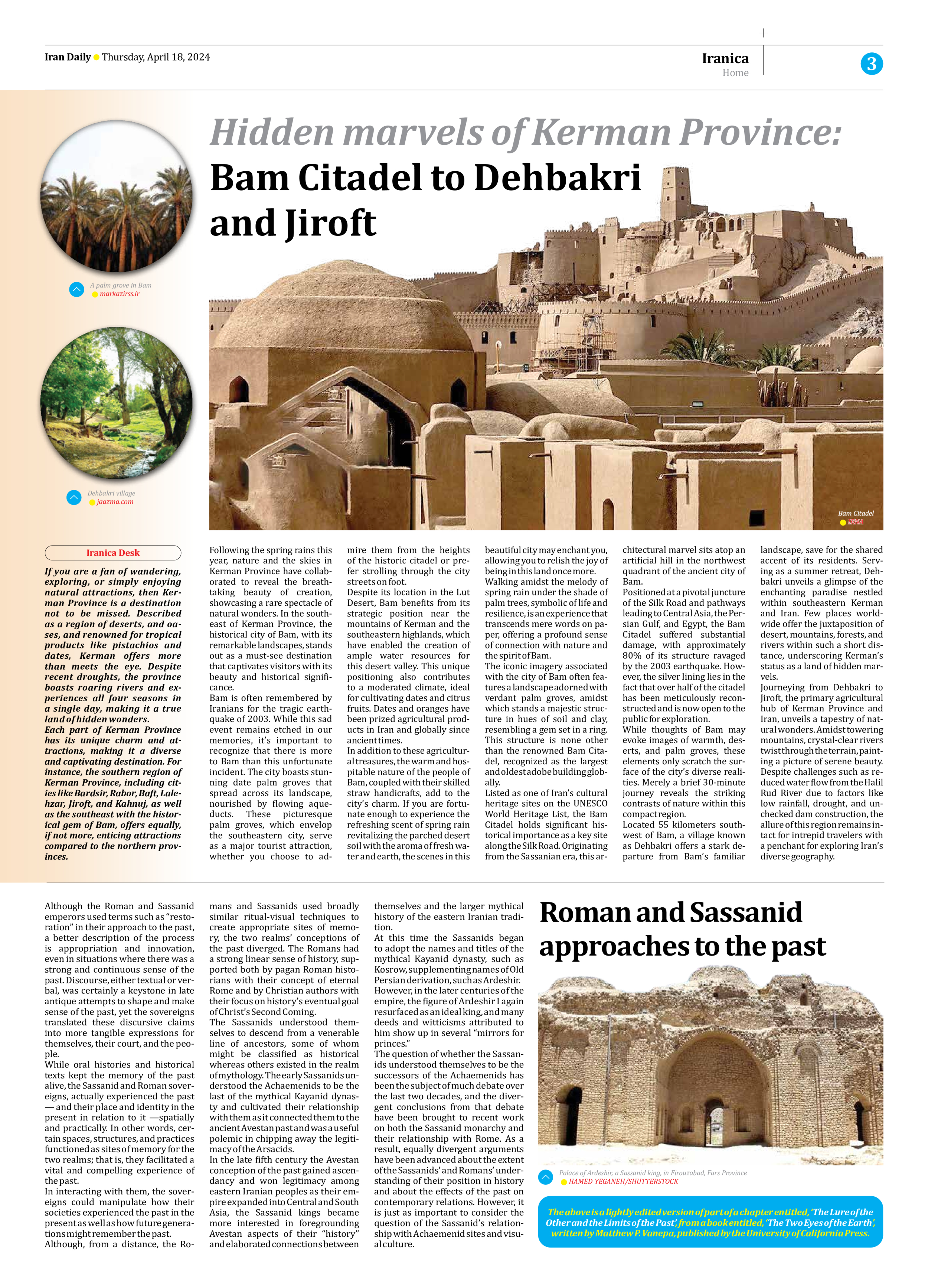
Hidden marvels of Kerman Province: Bam Citadel to Dehbakri and Jiroft
If you are a fan of wandering, exploring, or simply enjoying natural attractions, then Kerman Province is a destination not to be missed. Described as a region of deserts, and oases, and renowned for tropical products like pistachios and dates, Kerman offers more than meets the eye. Despite recent droughts, the province boasts roaring rivers and experiences all four seasons in a single day, making it a true land of hidden wonders. Each part of Kerman Province has its unique charm and attractions, making it a diverse and captivating destination. For instance, the southern region of Kerman Province, including cities like Bardsir, Rabor, Baft, Lalehzar, Jiroft, and Kahnuj, as well as the southeast with the historical gem of Bam, offers equally, if not more, enticing attractions compared to the northern provinces.
Following the spring rains this year, nature and the skies in Kerman Province have collaborated to reveal the breathtaking beauty of creation, showcasing a rare spectacle of natural wonders. In the southeast of Kerman Province, the historical city of Bam, with its remarkable landscapes, stands out as a must-see destination that captivates visitors with its beauty and historical significance.
Bam is often remembered by Iranians for the tragic earthquake of 2003. While this sad event remains etched in our memories, it’s important to recognize that there is more to Bam than this unfortunate incident. The city boasts stunning date palm groves that spread across its landscape, nourished by flowing aqueducts. These picturesque palm groves, which envelop the southeastern city, serve as a major tourist attraction, whether you choose to admire them from the heights of the historic citadel or prefer strolling through the city streets on foot.
Despite its location in the Lut Desert, Bam benefits from its strategic position near the mountains of Kerman and the southeastern highlands, which have enabled the creation of ample water resources for this desert valley. This unique positioning also contributes to a moderated climate, ideal for cultivating dates and citrus fruits. Dates and oranges have been prized agricultural products in Iran and globally since ancient times.
In addition to these agricultural treasures, the warm and hospitable nature of the people of Bam, coupled with their skilled straw handicrafts, add to the city’s charm. If you are fortunate enough to experience the refreshing scent of spring rain revitalizing the parched desert soil with the aroma of fresh water and earth, the scenes in this beautiful city may enchant you, allowing you to relish the joy of being in this land once more.
Walking amidst the melody of spring rain under the shade of palm trees, symbolic of life and resilience, is an experience that transcends mere words on paper, offering a profound sense of connection with nature and the spirit of Bam.
The iconic imagery associated with the city of Bam often features a landscape adorned with verdant palm groves, amidst which stands a majestic structure in hues of soil and clay, resembling a gem set in a ring. This structure is none other than the renowned Bam Citadel, recognized as the largest and oldest adobe building globally.
Listed as one of Iran’s cultural heritage sites on the UNESCO World Heritage List, the Bam Citadel holds significant historical importance as a key site along the Silk Road. Originating from the Sassanian era, this architectural marvel sits atop an artificial hill in the northwest quadrant of the ancient city of Bam.
Positioned at a pivotal juncture of the Silk Road and pathways leading to Central Asia, the Persian Gulf, and Egypt, the Bam Citadel suffered substantial damage, with approximately 80% of its structure ravaged by the 2003 earthquake. However, the silver lining lies in the fact that over half of the citadel has been meticulously reconstructed and is now open to the public for exploration.
While thoughts of Bam may evoke images of warmth, deserts, and palm groves, these elements only scratch the surface of the city’s diverse realities. Merely a brief 30-minute journey reveals the striking contrasts of nature within this compact region.
Located 55 kilometers southwest of Bam, a village known as Dehbakri offers a stark departure from Bam’s familiar landscape, save for the shared accent of its residents. Serving as a summer retreat, Dehbakri unveils a glimpse of the enchanting paradise nestled within southeastern Kerman and Iran. Few places worldwide offer the juxtaposition of desert, mountains, forests, and rivers within such a short distance, underscoring Kerman’s status as a land of hidden marvels.
Journeying from Dehbakri to Jiroft, the primary agricultural hub of Kerman Province and Iran, unveils a tapestry of natural wonders. Amidst towering mountains, crystal-clear rivers twist through the terrain, painting a picture of serene beauty. Despite challenges such as reduced water flow from the Halil Rud River due to factors like low rainfall, drought, and unchecked dam construction, the allure of this region remains intact for intrepid travelers with a penchant for exploring Iran’s diverse geography.







